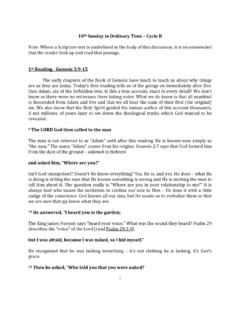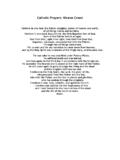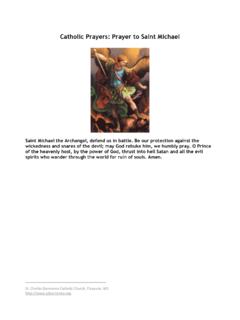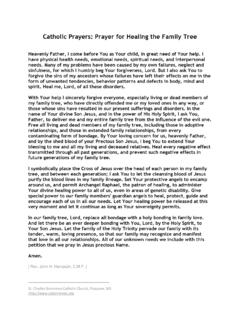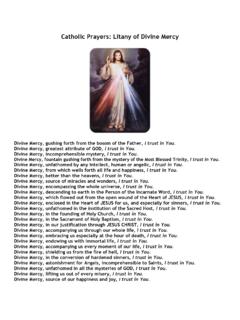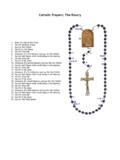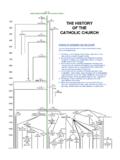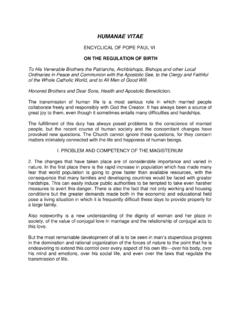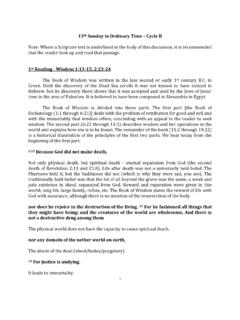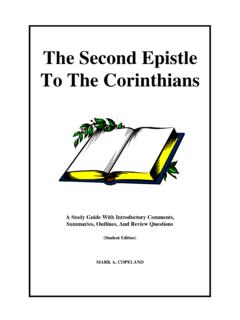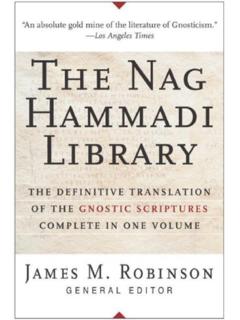Transcription of Hierarchy of the Church - Charles Borromeo
1 1 Hierarchy of the Church The Catholic Church has a hierarchical structure consisting of bishops, priests and deacons. The Bishop of Rome, the Pope, enjoys a special role in this hierarchical structure. However, the Primacy of the Pope is considered in a separate document. The focus here is on the offices of bishop, priest and deacon. Some anti-Catholics claim that these offices were not established by the Apostles, but were inventions of the Catholic Church sometime after the fourth century. The focus here will be on the teaching of the Church in first centuries. FIRST CENTURY Clement I (88-97) St. Clement makes a clear distinction between the clergy and the laity. After drawing a comparison with the division of priests in the Old Testament, he adds: The layman is bound by the rules laid down for the laity 1 He identifies the Hierarchy consisting of bishops, priests, and decons.
2 St. Ignatius of Antioch (50-115) St. Ignatius repeatedly stresses the importance of the bishop together with the priests and deacons in preserving the unity of the Church . The bishop is God s representative. Those who gather separately from the bishop cut themselves off from the true Church . The historian Philip Hughes points out that: By the time of St. Ignatius of Antioch ( the end of the first century, within thirty to forty years of the death of St. Paul) the new system the so-called monarchical episcopate is so universal that he [St. Ignatius] takes it for granted as the basis of his exhortations. 2 To the Ephesians It is proper, therefore, in every way to glorify Jesus Christ, who has glorified you, so that you, joined together in a united obedience and subject to the bishop and the presbytery [priests], may be sanctified in every respect.
3 3 United with him [the bishop], as the Church is with Jesus Christ and as Jesus Christ is with the Father, that all things might be harmonious in unity. Let no one be misled: if anyone is not within the sanctuary, he lacks the Bread of God [referencing Jn 6:33].. Let us, therefore, be careful not to oppose the bishop, or order that that we may be obedient to God. 4 1 Quasten, Patrology, Vol. I, p. 48 citing # 40. 2 Hughes, A History of the Church , Vol. 1, p. 50. 3 The Apostolic Fathers, # 2, p. 87. 4 The Apostolic Fathers, # 5, pp. 87-88. 2 To the Magnesians Be eager to do everything in godly harmony, the bishop presiding in the place of God and the presbyters in the place of the council of the apostles and the deacons, who are most dear to me, having been entrusted with the service of Jesus Let there be nothing among you which is capable of dividing you, but be united with the bishop and with those who lead, as an example and a lesson of incorruptibility.
4 5 Therefore as the Lord did nothing without the Father, either by himself or through the apostles for he was united with him, so you must not do anything without the bishop and the presbyters. 6 To the Trallians For when you are subject to the bishop as to Jesus Christ, it is evident to me that you are living not in accordance with human standards but in accordance with Jesus Christ, who died for us in order that by believing in his death you might escape death. 7 In the same way all should respect the deacons as they would Jesus Christ, just as they respect the bishop as representing the Father and the priests as the council of God and the college of the Apostles. Apart from these there is nothing that can be called a Church . 8 Anyone who is within the sanctuary is pure and anyone who is outside is impure, that is to say, no one who acts apart from the bishop and the priests and the deacons has a clear conscience.
5 9 To the Philadelphians For all those who belong to God and Jesus Christ are with the 10 Do nothing without the bishop. Guard your bodies as the temple of God. Love unity. Flee from divisions. 11 To the Smyrneans Wherever the bishop appears, there let the congregation be, just as wherever Jesus Christ is, there is the Catholic Church . 12 5 The Apostolic Fathers, # 6, pp. 94-95. 6 The Apostolic Fathers, # 7, p. 95. 7 The Apostolic Fathers, # 2, pp. 97-98. 8 Willis, The Teachings of the Church Fathers, # 114, p. 53. 9 The Teachings of the Church Fathers, # 115, p. 53. 10 The Apostolic Fathers, # 3, p. 107. 11 The Apostolic Fathers, # 7, p. 108 12 The Apostolic Fathers, # 8, pp. 112-113. This is the first use of the word catholic in Christian literature.
6 It is used here in the sense of universal. However, by the year 200 the term catholic is technical designation of the Catholic Church as opposed to heretical sects. See footnote # 109, p 113. 3 Let all follow the bishop as Jesus Christ did the Father, and the priests, as you would the Apostles. Reverence the deacons as you would the command of God. Apart from the bishop, let no one perform any of the functions that pertain to the Church . Let that Eucharist be held valid which is offered by the bishop or by one to whom the bishop has committed this charge. 13 The Shepherd of Hermas (First/Second Century) The tower which you see being built is I, the Church , which appeared to you now and But the tower has been set on a foundation by the word of the almighty and glorious Name, and is strengthened by the unseen power of the Master.
7 14 The stones that are square and white and fit at their joints, are the apostles and bishops and teachers and deacons who have walked according to the holiness of God and have ministered to the elect of God as bishops and teachers and deacons with purity and reverence. 15 SECOND CENTURY St. Irenaeus (180-200) It is within the power of all, therefore, in every Church , who may wish to see the truth, to contemplate clear the tradition of the apostles manifested throughout the whole world; and were in a position to reckon up those who were by the apostles instituted bishops in the Churches, and [to demonstrate] the succession of these men to our own times; those who neither taught nor knew of anything like what these [heretics] now rave about.
8 16 Suppose there arise a dispute relative to some important question among us, should we not have recourse to the most ancient Churches with which the apostles held constant intercourse, and learn from them what is certain and clear in regard to the present question? For how should it be if the apostles themselves had not left us writings? Would it not be necessary [in that case] to follow the course of the tradition which they handed down to those to whom they did commit the Churches? 17 Now all these [heretics] are of much later date than the bishops to whom the apostles committed the Churches;.. {These heretics] are forced into various But the path of those belonging to the Church circumscribes the whole world, as possessing the sure tradition from the apostles, and gives unto us to see that the faith of all is one and the same.}
9 18 13 The Teachings of the Church Fathers, # 117, pp. 14 The Apostolic Fathers, Vision , pp. 202, 203 15 Ibid., Vision , p. 204. 16 Against Heresies, Bk. 3, Chapter 3, Willis, The Teaching of the Church Fathers, p. 76. 17 Against Heresies, Bk. 3, Chapter 4, Willis, The Teaching of the Church Fathers, p. 63. 18 Against Heresies, Bk. 5, Chapter 20, Willis, The Teaching of the Church Fathers, p. 64 4 The true gnosis is the doctrine of the Apostles, and the ancient organization of the Church throughout the whole world, and the manifestation of the body of Christ according to the successions of bishops, by which successions the bishops have handed down the Church which is found everywhere; and the very complete tradition of the Scriptures, which have come down to us by being guarded against falsification, and which are received without addition or deletion; and reading without falsification, and a legitimate and diligent exposition according to the Scriptures, without danger and without blasphemy.
10 19 But Polycarp also was not only instructed by apostles, and conversed with many who had seen Christ, but was also, by apostles in Asia, appointed bishop of the Church in Smyrna, who I also saw in my early youth, for he tarried [on earth] a very long time, and, when a very old man, gloriously and most nobly suffered martyrdom, departed this life, having always taught the things which he learned from the apostles, and which the Church has handed down, and which alone are true. To these things all the Asiatic Churches testify, as do also those men who have succeeded Polycarp down to the present time. 20 It is necessary to obey those who are the presbyters in the Church , those who, as we have shown, have succession from the Apostles; those who have received, with the succession of the episcopate, the sure charism of truth according to the good pleasure of the Father.
